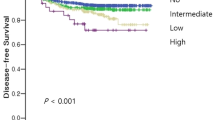Abstract
Purpose
Tumor grade is a traditional prognostic parameter in colorectal cancer. Remarkably, however, there is still no generally accepted consensus how to perform tumor grading. In this study, we systematically compared the prognostic value of traditional grading based upon histological features, that is, gland formation alone with grading based upon both histological and cytological features, such as nuclear pleomorphism and anaplasia (“alternative grade”).
Methods
Three hundred eighty-one tumors of randomly selected patients were retrospectively reviewed. Traditional and alternative tumor grades were related to various clinicopathological features and to progression-free and cancer-specific survival applying both univariate and multivariate testing.
Results
Traditional and alternative tumor grades were significantly associated with T and N classification, tumor size, lymphovascular invasion, as well as both progression-free and cancer-specific survival. In Cox’s proportional hazards regression models, the alternative grade was superior to the traditional tumor grade and was significantly associated with progression-free survival (hazard ratio 1.57, 95 % confidence interval 1.04–2.35; p = 0.031), independent of patients’ age and gender, T and N classification, and lymphovascular invasion. Likewise, patients with tumors with high alternative grade were more likely to die of disease (hazard ratio 1.30, 95 % confidence interval 0.85–2.00), but this difference was not statistically significant (p = 0.22).
Conclusions
Tumor grade based upon both histological and cytological features was superior to grade based upon histological features alone and proved to be an independent prognostic parameter. Thus, tumor grade based upon both histological and cytological features may help to improve prognostic stratification and may thereby affect clinical decision-making and patient management.


Similar content being viewed by others
References
Jemal A, Bray F, Center MM, Ferlay J, Ward E, Forman D (2009) Global cancer statistics. CA Cancer J Clin 61:69–90. doi:10.3322/caac.20107
Brenner H, Kloor M, Pox CP (2014) Colorectal cancer. Lancet 383:1490–1502. doi:10.1016/S0140-6736(13)61649-9
Malvezzi M, Bertuccio P, Levi F, La Vecchia C, Negri E (2014) European cancer mortality predictions for the year 2014. Ann Oncol 25:1650–1656. doi:10.1093/annonc/mdu138
Dotan E, Cohen SJ (2011) Challenges in the management of stage II colon cancer. Semin Oncol 38:511–520. doi:10.1053/j.seminoncol.2011.05.005
Sagaert X (2014) Prognostic biomarkers in colorectal cancer: where do we stand? Virchows Arch 464:379–391. doi:10.1007/s00428-013-1532-z
Hamilton S, Bosman F, Boffetta P (2010) Carcinoma of the colon and rectum. In: Bosman F, Carneiro F, Hruban R, Theise N (eds) World health organization classification of tumours of the digestive system. IARC Press, Lyon, pp 131–181
Zaino A, Carinelli SG, Ellenson LH, Eng C, Katabuchi H, Konishi I, Lax S, Matias-Giu X, Mutter GL, Peters WA, Sherman ME, Shih IM, Soslow R, Stewart CJR (2014) Tumours of the uterine corpus: epithelial tumours and precursors. In: Kurman R, Carcangiu M, Herrington C, Young R (eds) World health organization classification of tumours of female reproductive organs. IARC Press, Lyon, pp 121–154
Moertel CG, Fleming TR, Macdonald JS, Haller DG, Laurie JA, Goodman PJ, Ungerleider JS, Emerson WA, Tormey DC, Glick JH et al (1990) Levamisole and fluorouracil for adjuvant therapy of resected colon carcinoma. N Engl J Med 322:352–358. doi:10.1056/NEJM199002083220602
Sobin S, Gospodarowicz M, Wittekind C (2010) TNM classification of malignant tumours, 7th edn. Wiley-Blackwell, West Sussex
Betge J, Langner C (2011) Vascular invasion, perineural invasion, and tumour budding: predictors of outcome in colorectal cancer. Acta Gastroenterol Belg 74:516–529
Grinnell RS (1939) The grading and prognosis of carcinoma of the colon and rectum. Ann Surg 109:500–533. doi:10.1097/00000658-193904000-00002
Kuijpers C, Sluijter CE, Overbeek LIH, von der Thusen JH, Grunberg K, van Diest PJ, Jiwa M, Nagtegaal ID, Willems SM (2015) Interlaboratory variability in the histological grading of colorectal adenocarcinomas in a nationwide cohort. Virchows Arch 467:S182–S183
Morson B, Dawson I, Spriggs A, Jones F (1979) Gastrointestinal pathology, 2nd edn. Blackwell Scientific Publications, Oxford
Morson B, Sobin L (1976) Histological typing of intestinal tumours. World Health Organization, Geneva
Jass J, Sobin L (1989) World health organization, histological typing of intestinal tumours. Springer, Berlin, Heidelberg
Hamilton SR, Vogelstein B, Kudo S, Riboli E, Nakamura S, Hainaut P, Rubio CA, Sobin LH, Fogt F, Winawer SJ, Goldgar DE, Jass JR (2000) Carcinoma of the colon and rectum. In: Hamilton S, LA A (eds) Pathology and genetics of tumours of the Digestive system. IARC Press, Lyon, pp 105–119
Qualheim RE, Gall EA (1953) Is histologic grading of colon carcinoma a valid procedure? AMA Arch Pathol 56:466–472
Quirke P, Dyson JE, Dixon MF, Bird CC, Joslin CA (1985) Heterogeneity of colorectal adenocarcinomas evaluated by flow cytometry and histopathology. Br J Cancer 51:99–106. doi:10.1038/bjc.1985.14
Halvorsen TB, Seim E (1988) Degree of differentiation in colorectal adenocarcinomas: a multivariate analysis of the influence on survival. J Clin Pathol 41:532–537. doi:10.1136/jcp.41.5.532
Thomas GD, Dixon MF, Smeeton NC, Williams NS (1983) Observer variation in the histological grading of rectal carcinoma. J Clin Pathol 36:385–391. doi:10.1136/jcp.36.4.385
Vobecky J, Leduc CP, Devroede G, Madarnas P (1989) The reliability of routine pathologic diagnosis of colorectal adenocarcinoma. Cancer 64:1261–1265
Chandler I, Houlston RS (2008) Interobserver agreement in grading of colorectal cancers—findings from a nationwide web-based survey of histopathologists. Histopathology 52:494–499. doi:10.1111/j.1365-2559.2008.02976.x
Author information
Authors and Affiliations
Corresponding author
Ethics declarations
Conflict of interest
The authors declare no conflict of interest and no extrainstitutional funding.
Rights and permissions
About this article
Cite this article
Resch, A., Harbaum, L., Pollheimer, M.J. et al. Inclusion of cytological features in tumor grading improves prognostic stratification of patients with colorectal cancer. Int J Colorectal Dis 31, 535–541 (2016). https://doi.org/10.1007/s00384-015-2495-0
Accepted:
Published:
Issue Date:
DOI: https://doi.org/10.1007/s00384-015-2495-0




